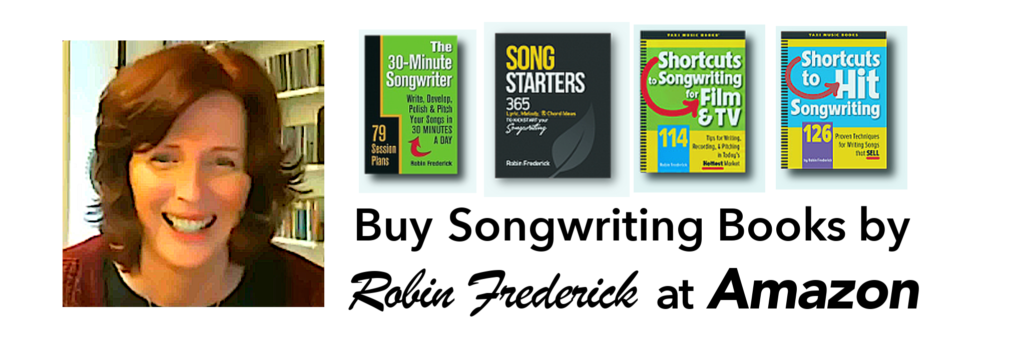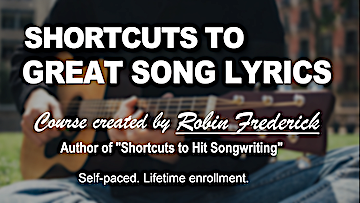Whether you want to write a song to pitch to music publishers, TV shows and commercials, or record them yourself as an artist, here’s a songwriting method that will help you get your message across and make sure your listeners stay involved from beginning to end. Of course, this is just one approach to songwriting but it’s used by many songwriting pros and it works.
CREATE THE RAW MATERIAL FOR YOUR LYRIC
#1 Start your song with the title.

Starting with a title will help you stay focused on a single idea in your song. Create a phrase of one to six words that sums up the heart of what you want to say. Or look for an interesting phrase that suggests a situation or emotion to you. Try using an image in your title to give it more interest or an action word to give it energy. For more tips on writing song titles read Write a Memorable Title or watch this video.
#2 Make a list of questions suggested by the title.

Start by asking yourself what you want to say about your title and what you think your listeners might want to know.
Make list of questions. Your list might include: What does the title mean? How do you feel about it? What happened to cause this? What do you think or hope will happen next? You’ll need three to four questions. Check out this video for more information.
#3 Choose a song structure.

Many of today’s biggest hits rely on a song structure like this:
Verse / Chorus / Verse / Chorus / Bridge / Chorus.
Many hit songs add a section called a “pre-chorus” or “lift” between the verse and chorus to build anticipation.
The verse, pre-chorus, and chorus each have an identifiable melody, one that the listener can recognize when it comes around. Here’s a tip that will tell you more about song structure. Or watch this video to learn the basics.
#4 Choose one question to answer in the chorus and one for each verse.

We’ll focus on the chorus first since it’s the most important part of your song. Select the question you want to answer in your chorus. Write down a short phrase that expresses your answer.
Look for images and action words to bring your answers to life. What is the singer feeling, thinking, or saying? What emotion is the singer feeling and how would you describe it? Is it warm or cold? Dark or light? Read more about adding emotion to your lyrics here.
GET TO WORK ON YOUR MELODY & CHORDS
#5 Find the melody in your lyric.

Choose one or two of the phrases you came up with in Step 4. Say them out loud. Now say them again with LOTS of emotion. Exaggerate the emotion in the lines. Notice the natural rhythm and melody of your speech when you say the lines with lots of feeling. This is the beginning of your chorus melody. Play with it until it feels comfortable. Here’s more on using your lyric to create a melody.
#6 Begin to add chords to your chorus melody.

Try a simple, repeated chord pattern. You’ll find a several chord progressions you can use here. (Scroll down to the section on Chord Progressions.) Play with the melody and chords until you find something you like. Record yourself singing and playing (or just singing) – even if it’s only on your smartphone. Be sure you get it down so you don’t forget it.
DEVELOP YOUR SONG IN SECTIONS
#7 Work on the lyric in your first verse.

Focus on the question you chose in Step 4. Make your first line something that will get listeners interested: an intriguing statement, a question, or a description of the situation. In your second line, consider restating the first line in a different way or adding more information. Don’t move on too quickly; your listeners need time to understand what’s happening in the song.
In Verse 1, be sure to give listeners enough information so they can understand the chorus when you get there. Go through Steps 5 and 6 with your verse melody and chords.
#8 Connect your verse and chorus.

After you have a verse and chorus, create a transition between them so that they flow naturally. You may need to raise or lower your verse melody or change the last line to get to your chorus smoothly.
TIP: Chorus melodies are usually in a higher note range than verses because they’re more emotional, and when we get emotional our voices tend to rise.
#9 Build your second verse and bridge.

Choose another of your questions to answer in your second verse. Use Step 7 to work through the lyric. Your second chorus will have the same melody and lyric as your first chorus, so you are now almost finished with your song. You just need to add a bridge.
The bridge section adds a peak emotional moment to your song, a realization, or an “aha!” moment. Try two or three lyric lines that give the listener the best insight you can into the situation or emotion the singer is feeling. The melody should be different from both verse and chorus. Try using a chord you haven’t used before or changing the phrase lengths or motion of the melody. A bridge isn’t a requirement but it can add a lot of strength to your song.
SHARE YOUR SONG WITH LISTENERS
#10 Record your song.

It’s one thing to write a song, but it’s another to make sure that listeners hear the feelings you wanted to express. A simple piano/vocal or guitar/vocal can often be the most effective emotional statement of your song. If you wrote a Rock song, do an “unplugged” version. You don’t need lots of synthesizers or drums—in fact, these can detract.
Practice both the instrumental and vocal parts until you are comfortable with them. The less you have to focus on when playing or singing, the more you can let go and feel the emotion in the song. Try singing it as if you are speaking it to someone. Record for short periods then take a break. Keep the song and the emotion fresh! Here’s a post that will give you more ideas on how to record a rough demo.
Now that you know how to write a song in ten steps, here are some great Song Starters – titles, themes, chord progressions, and more – to get you going.
Visit my Tips and Inspiration website. I’ll take you on a deep dive into some of today’s biggest hits and show you the techniques they use to appeal to millions of listeners. Then you can try those same techniques yourself. It’s all free on my website Robin Frederick Presents Secrets of Hit Songwriting.


